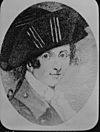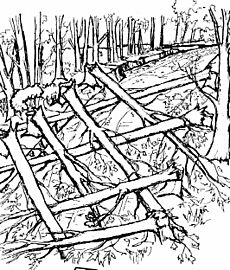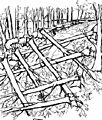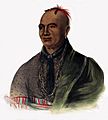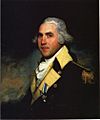Siege of Fort Stanwix facts for kids
Quick facts for kids Siege of Fort Stanwix |
|||||||
|---|---|---|---|---|---|---|---|
| Part of American Revolutionary War | |||||||
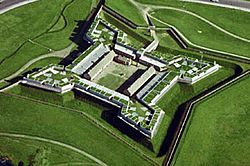 Aerial view of the reconstructed Fort Stanwix |
|||||||
|
|||||||
| Belligerents | |||||||
|
Iroquois |
|
||||||
| Commanders and leaders | |||||||
|
Joseph Brant |
|
||||||
| Strength | |||||||
| 750 regulars and militia 800 Indians |
750 regulars (Gansevoort) 800 militia (Herkimer) 700 regulars 100–300 militia and Indians (Arnold) |
||||||
| Casualties and losses | |||||||
|
British, Hessian, Loyalist
Indians
|
|
||||||
The Siege of Fort Stanwix was an important event in the American Revolutionary War. It happened in 1777, from August 2 to August 22. This siege is also known as the Siege of Fort Schuyler.
Fort Stanwix was a key defense point for the American forces. It was located in the western part of the Mohawk River Valley in New York. American soldiers from New York and Massachusetts defended the fort. Their commander was Colonel Peter Gansevoort.
The attacking forces were British soldiers, American Loyalists, and Hessian soldiers from Germany. They also had many Native American allies. British Brigadier General Barry St. Leger led these forces. The Iroquois leader Joseph Brant also played a big role.
St. Leger's attack was a plan to help another British general, John Burgoyne. Burgoyne was trying to take control of the Hudson River Valley.
During the siege, American help tried to reach the fort. A group of New York militia, led by Nicholas Herkimer, was stopped. This led to the Battle of Oriskany on August 6. While the fort's defenders were not in that battle, they did attack the empty enemy camps. This raid lowered the spirits of St. Leger's Native American allies.
The siege ended when more American soldiers arrived. These troops were led by Benedict Arnold. Arnold used a clever trick to make the British think a much larger force was coming. This trick, along with the Native Americans leaving, made St. Leger give up. He abandoned the siege and retreated.
St. Leger's failure to capture Fort Stanwix was a big blow to the British. It helped lead to Burgoyne's surrender later in 1777 at the Battles of Saratoga.
An important moment happened on August 3, 1777, at Fort Schuyler. The first official US flag was flown there during the battle. The Continental Congress had decided on the flag's design in June 1777. Soldiers at the fort used their shirts for white stripes. They found red fabric from officers' wives' clothing. A blue coat from Captain Abraham Swartwout was used for the blue field with stars.
Contents
Why Fort Stanwix Was Important
Fort Stanwix was built in a very important spot. This spot was called the Oneida Carrying Place. It was a narrow strip of dry land between the Mohawk River and Wood Creek. The Mohawk River flowed to the Hudson River. Wood Creek led to Lake Ontario. This meant the fort controlled a key travel route.
The British built the fort in 1758 during the French and Indian War. Over time, it fell apart. But when the American Revolutionary War started, this location became important again. It was a vital defense point between New York and Quebec.
British leaders, like Lord Germain and General John Burgoyne, planned to control the Hudson River valley. Part of their plan was a "diversion" on the Mohawk River. This diversion was given to Lieutenant Colonel Barry St. Leger. He was a skilled fighter from the French and Indian War.
Gathering Forces for Battle
In April 1777, American Major General Philip Schuyler ordered Colonel Peter Gansevoort to fix up Fort Stanwix. Gansevoort's 3rd New York Regiment arrived in May and started working hard. They officially renamed it Fort Schuyler, but many still called it Fort Stanwix.
Friendly Oneida Native Americans warned the Americans. They said the British were planning an attack on the Mohawk Valley. By mid-July, these warnings were confirmed. This made the Americans work even faster on the fort's defenses. Gansevoort told Schuyler that they were low on supplies. Schuyler ordered more supplies to be sent on July 8.
St. Leger gathered his own diverse army. It included British soldiers, German jäger, Loyalists, and Canadien laborers. He also had some cannons and mortars. He thought the fort had only about 60 defenders and was in bad shape. This was the information he had when he left Lachine, near Montreal, on June 23.
St. Leger soon learned that the Americans had many more soldiers at Fort Stanwix. He found out the fort had been repaired and had over 600 defenders. An Indian agent named Daniel Claus convinced St. Leger to go to Oswego, New York. There, Joseph Brant and about 800 Native Americans joined the expedition. These were mainly Mohawks and Senecas, plus warriors from other Iroquois League tribes. The Oneidas and Tuscaroras remained neutral.
St. Leger's main force had trouble reaching Fort Stanwix. The Americans had cut down trees to block Wood Creek. This forced St. Leger's men to build a new road. St. Leger sent Brant with 200 Native Americans and 30 soldiers to stop American supplies. But Brant arrived too late on August 2. The American supply convoy had already reached the fort.
The Siege Begins
St. Leger first tried to scare the fort's defenders. He paraded his troops, including the Native Americans in their war clothes. When this didn't work, he sent a message demanding surrender. Colonel Gansevoort refused to answer.
St. Leger then started the siege. He set up his soldiers and cannons north of the fort. Most of the Native Americans and Loyalists were to the south. They also had a line of camps along the Mohawk River.
St. Leger's cannons were delayed. Gansevoort's men had cut down trees across the path leading to the fort. This was a tactic also used against Burgoyne's army. St. Leger's men had to clear the path for the cannons. This work kept most of his white soldiers busy. The Native Americans mostly surrounded the fort.
On August 5, St. Leger received news. Joseph Brant's sister, Molly, told him that an American relief army was coming.
The Battle of Oriskany
The local Tryon County Committee of Safety learned about St. Leger's attack on July 30. They quickly gathered more troops. On August 4, about 800 local militia men gathered. They were led by Nicholas Herkimer. By the next day, they were about 10 miles from Fort Stanwix.
St. Leger learned of their approach. He sent soldiers, rangers, and most of his Native American allies to stop Herkimer. They set up an ambush. A very bloody fight happened near Oriskany Creek. Both sides lost many soldiers. Herkimer was badly wounded in the leg. The Americans pushed back St. Leger's group. But Herkimer's men had to retreat because of their heavy losses. Herkimer later died from his wounds.
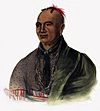
During this battle, the fort's defenders took action. Gansevoort's second-in-command, Marinus Willett, led 250 men out of the fort. They raided the nearly empty Native American camps. They took "several wagon-loads of spoils." This included important British plans and a letter meant for Gansevoort.
When the British and Native American forces returned from Oriskany, their camps were empty. Many personal items and blankets were gone. This, combined with the many Native American lives lost at Oriskany, made them very angry. They had been told that the white soldiers would do most of the fighting. This broken trust hurt the relationship between the Native Americans and St. Leger. It was a big reason why the siege failed.
St. Leger again demanded the fort's surrender. Gansevoort refused. The next day, St. Leger sent a third demand. He falsely claimed Burgoyne was in Albany. He also threatened that the Native Americans would attack the fort's defenders and local towns. Lieutenant Colonel Willett bravely refused. He told the British officers their message was "degrading" and "not reputable."
During a short ceasefire, Gansevoort sent Willett and another officer to tell Schuyler about their situation. They traveled through swamps and past British lines. They eventually met an American relief force led by Major General Benedict Arnold.
Help Arrives and the Siege Ends
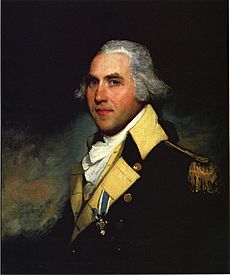
General Schuyler heard about the Battle of Oriskany on August 8. He sent soldiers to help the fort. On August 12, Schuyler held a meeting. They discussed how to deal with St. Leger and Burgoyne. Many thought they should not send more troops to Fort Stanwix. But Schuyler insisted on a relief mission. Benedict Arnold offered to lead it.
By August 20, Arnold and 700 American soldiers reached Fort Dayton. Arnold tried to get more local men to join him, but only about 100 did. He waited, hoping more friendly Native Americans would join. But then he heard the siege was critical.
St. Leger realized his cannons were not strong enough from far away. He started digging trenches closer to the fort. Gansevoort reported that the trenches were very close to one of the fort's defenses.
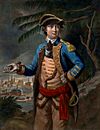
Arnold had too few soldiers for a direct attack. So, he decided to use a trick. He had arrested some Loyalists at Fort Dayton, including Hon Yost Schuyler. Hon Yost knew many of the Mohawk Native Americans attacking Fort Stanwix. Arnold convinced Hon Yost to spread rumors. The rumors said that a huge American army, led by "The Dark Eagle" (Arnold), was coming. Hon Yost's brother was held hostage to make sure he followed through.
Arnold's trick worked. On August 21, St. Leger wrote that "Arnold was advancing... with 3,000 men." Even though Arnold was still at Fort Dayton. St. Leger held a meeting with his Native American allies. About 200 had already left. The rest were unhappy with the siege and their losses. They threatened to leave if St. Leger didn't stop the siege.
On August 22, St. Leger gave up. He packed up his camp and started the long journey back to Lake Ontario. He left behind a lot of equipment. Many of his men deserted or were captured by the fort's defenders, including Hon Yost.
What Happened Next
Arnold's force, now joined by friendly Native Americans, marched towards Fort Stanwix. On August 23, a messenger told him St. Leger had left. Arnold reached the fort that evening. The next day, Arnold sent 500 men to chase St. Leger. St. Leger's retreating army was also being bothered by his former Native American allies.
St. Leger eventually reached Fort Ticonderoga on September 29. But it was too late to help Burgoyne.
Burgoyne blamed his campaign's failure partly on St. Leger. He thought St. Leger's failure to take the Mohawk valley was a big problem. He also hoped St. Leger's arrival at Ticonderoga would help his retreat. But Burgoyne was already surrounded and surrendered after the Battle of Bemis Heights.
Fort Stanwix did not see much more fighting after the siege. It was a dangerous place because of attacks by Loyalists and hostile Native Americans. In 1779, the American army used the fort to launch an attack on Onondaga Castle. In 1780, Native Americans led by Joseph Brant blocked the fort for several days. Finally, in 1781, a flood and fire destroyed most of the fort. The Americans then left the post.
Fort Stanwix Today
Fort Stanwix was destroyed in the 1800s. In 1935, the site was named a U.S. National Monument. But private businesses and homes were on the land in downtown Rome, New York. In 1961, it became a National Historic Landmark. In the 1970s, the National Park Service rebuilt the fort. This created the Fort Stanwix National Monument we see today.
Images for kids
-
19th century illustration of Joseph Brant
-
Peter Gansevoort, oil painting by Gilbert Stuart
-
A 1776 mezzotint of Benedict Arnold


